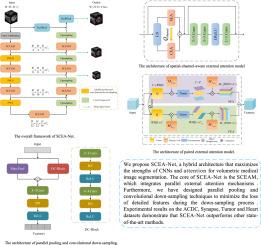SCEA-Net:一个基于空间通道感知的外部注意力的混合框架,用于精确的3D医学图像分割
IF 4.9
2区 医学
Q1 ENGINEERING, BIOMEDICAL
引用次数: 0
摘要
准确的医学图像分割对疾病的诊断和治疗至关重要。尽管基于卷积神经网络(cnn)的方法已经提供了显著的分割结果,但由于卷积算子的固有局限性,它们在捕获远程依赖关系方面面临挑战。另一方面,基于变压器的方法可以通过自关注建立这种依赖关系,但它们的计算复杂度为二次,使得处理3D输入具有挑战性。此外,它们在编码阶段的池化操作往往会导致特征丢失,并且它们提取多尺度上下文信息的能力受到限制。为了克服这些挑战,我们引入了SCEA-Net,这是一种为精确的3D医学图像分割而量身定制的新方法。SCEA-Net的核心是空间通道感知外部注意模型(SCEAM),该模型将并行外部注意机制与卷积相结合,以有效捕获关键的空间和通道信息。这种注意机制利用基于内存的存储单元来考虑数据集中所有样本之间的潜在关系,同时还通过线性计算方法降低模型复杂性。此外,我们还设计了并行池化和卷积下采样,以尽量减少下采样过程中细节特征的损失。ACDC、Synapse、Tumor和心脏左心房分割数据集的实验结果表明,SCEA-Net优于其他最先进的方法,验证了我们方法的有效性。本文章由计算机程序翻译,如有差异,请以英文原文为准。

SCEA-Net: A hybrid framework from spatial-channel-aware external attention for accurate 3D medical image segmentation
Accurate medical image segmentation is essential for disease diagnosis and treatment. Although methods based on convolutional neural networks (CNNs) have delivered remarkable segmentation outcomes, they face challenges in capturing long-range dependencies due to the inherent limitations of convolution operators. On the other hand, transformer-based methods can establish such dependencies through self-attention, but they suffer from quadratic computational complexity, making it challenging to process 3D inputs. Additionally, the pooling operation in their encoding stage often results in feature loss, and their ability to extract multi-scale contextual information is limited. To overcome these challenges, we introduce SCEA-Net, a novel approach tailored for precise 3D medical image segmentation. The core of SCEA-Net is the spatial-channel-aware external attention model (SCEAM), which integrates parallel external attention mechanisms with convolutions to effectively capture crucial spatial and channel information. This attention mechanism leverages memory-based storage units to consider potential relationships among all samples in the dataset, while also reducing model complexity through linear computation methods. Furthermore, we have designed parallel pooling and convolutional down-sampling to minimize the loss of detailed features during the down-sampling process. Experimental results on the ACDC, Synapse, Tumor and cardiac left atrium segmentation datasets demonstrate that SCEA-Net outperforms other state-of-the-art methods, validating the effectiveness of our approach.
求助全文
通过发布文献求助,成功后即可免费获取论文全文。
去求助
来源期刊

Biomedical Signal Processing and Control
工程技术-工程:生物医学
CiteScore
9.80
自引率
13.70%
发文量
822
审稿时长
4 months
期刊介绍:
Biomedical Signal Processing and Control aims to provide a cross-disciplinary international forum for the interchange of information on research in the measurement and analysis of signals and images in clinical medicine and the biological sciences. Emphasis is placed on contributions dealing with the practical, applications-led research on the use of methods and devices in clinical diagnosis, patient monitoring and management.
Biomedical Signal Processing and Control reflects the main areas in which these methods are being used and developed at the interface of both engineering and clinical science. The scope of the journal is defined to include relevant review papers, technical notes, short communications and letters. Tutorial papers and special issues will also be published.
 求助内容:
求助内容: 应助结果提醒方式:
应助结果提醒方式:


